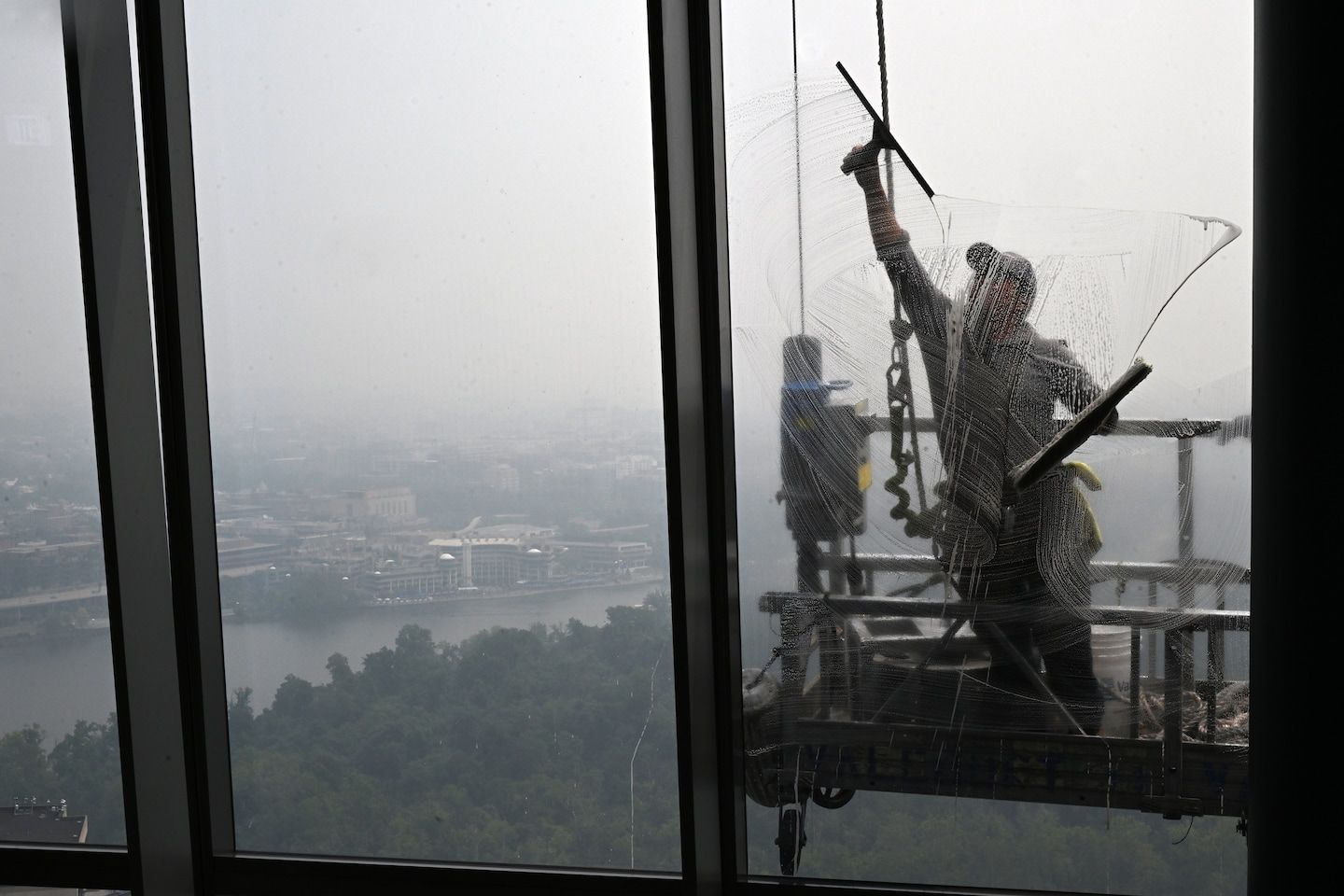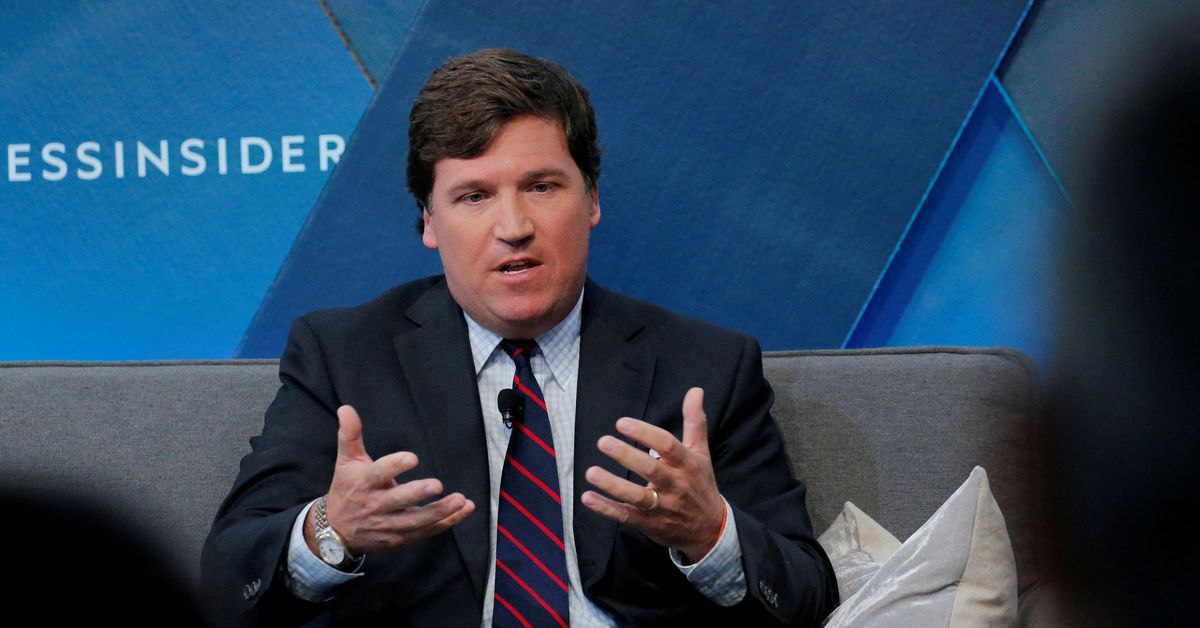Outdoor workers endure wildfire smoke, hazardous air quality
Listen 9 min Comment on this story Comment Gift Article Share
NEW YORK — Joel Polanzo, a security guard for an office building in Manhattan’s Columbus Circle, is used to standing outside and breathing air laden with exhaust fumes, dust and other city pollution. But nothing compares to the past couple of days. Want to know how your actions can help make a difference for our planet? Sign up for the Climate Coach newsletter, in your inbox every Tuesday and Thursday. ArrowRight “It’s been terrible,” Polanzo, 23, said Thursday, at his outdoor post once again, but this time wearing a mask. “It’s like being next to a barbecue and smoking all the carbon that’s coming out.”
From dog walkers to delivery drivers, from landscapers to farm laborers, many workers whose jobs require time in the outdoors have plowed on this week, even as smoke from wildfires raging in Canada has created abysmal air quality up and down the East Coast. Their predicament reveals how outdoor laborers, more than any other segment of the workforce, remain vulnerable when it comes to climate change.
Heavy smoke from Canadian wildfires moved across the Northeast on June 8, leaving hazy skies and spreading health concerns from New York to Washington. (Video: The Washington Post)
Across the globe, these men and women are more likely to fall ill and die of exposure to extreme heat, which can be intensified by rising humidity. From construction workers in Nepal to sugar cane harvesters in El Salvador to landscapers in Las Vegas and moped drivers in India, laboring outside poses major health risks. Workers can become overheated, suffer long-term damage to their kidneys or breathe in unhealthy air that can cause major respiratory illness.
In the United States this week, as code red and code purple alerts have proliferated among areas that are home to tens of millions of Americans, some workplaces have taken steps to limit the exposure of their employees to the polluted air.
Major League Baseball postponed multiple games this week. A restaurant owner in Philadelphia shut down outdoor dining at some locations to keep staff out of harm’s way. The city of Allentown, Pa., sent parks and recreation workers home. Amtrak was among numerous companies that made masks available to workers that wanted them, and said it would delay “noncritical” work in areas deemed hazardous.
Advertisement
“If it is feasible, I would encourage not working outside,” said Panagis Galiatsatos, a pulmonary medicine physician at Johns Hopkins School of Medicine and a spokesman for the American Lung Association.
But he also knows that for many people in the path of wildfire smoke this week, that option simply isn’t a reality. “If people have to work outdoors, by all means take the proper precautions to stay safe,” he said.
That includes wearing a high-quality, tightfitting mask outdoors, staying hydrated and putting off any jobs that can wait a couple days. People who drive a lot for work should keep make sure the air conditioner circulates only the inside air, he said.
Joel Kaufman, a University of Washington epidemiologist and physician, said the harmful air quality fueled by the wildfires doesn’t affect everyone equally. Older workers and those with preexisting conditions typically face higher risks than healthy, younger people.
Advertisement
“We have an aging workforce in this country. People who are outside doing exertional work are not always 20-somethings,” Kaufman said. That’s why employers face an onus to think carefully about the risks for all employees.
“From an employer perspective, you should really be more conservative,” Kaufman said. “If the guidance is that it’s hazardous for all people, then you really shouldn’t be sending people out to work in that situation.”
But in reality, outdoor work plowed on unabated for many people up and down the East Coast this week, despite the thick, dirty and potentially dangerous air that spread across hundreds of miles.
In Philadelphia’s famous 9th Street Market on Thursday, Keith Garrett, 37, was giving a friend a hand selling fruit and vegetables. He had a mask around his chin as he sold bunches of asparagus for $1 each and bananas for 50 cents a pound. Business was noticeably down, he said.
Advertisement
“There’s nobody outside,” he said. “They caused panic telling people to stay inside.”
Some states in the West, where wildfires have historically been more common and disruptive, have taken action to protect workers exposed to potentially toxic air each year. In recent years, Oregon, California and Washington have adopted rules that require employers to provide protection such as N95 masks to protect workers when wildfire smoke degrades air quality — and, if possible, to move workers indoors in certain cases.
But are no such detailed standards at the federal level as yet.
Data show that millions of Americans rely on time outside as part of their livelihood.
As of 2020, according to the Bureau of Labor Statistics, 4.3 percent of civilian workers were required to spend more than two-thirds of their workday outdoors, including landscaping crews, construction laborers and highway maintenance workers. Another 15.1 percent were required to be outdoors as much as a third of their workday, including preschool teachers, truck drivers, carpenters and reporters.
As climate change fuels more intense wildfires, stronger storms and more crippling heat waves, scientists have warned that outdoor workers around the globe are likely to face more challenging conditions, more often. But many governments have resisted taking action, as businesses have fought stricter standards that could make it more expensive to operate.
The warming planet is “making hot areas even hotter and drastically reducing the time people can spend outside, which means that some outdoor workers cannot work the required hours and thus will earn less,” the Intergovernmental Panel on Climate Change wrote in a sprawling report last year.
Advertisement
On Thursday, few workers were thinking about what might lie decades ahead, and instead were trying simply to endure the smoky shifts before them.
Some Targets shut down curbside delivery amid the haze, according to Adam Ryan, founder of the nonaffiliated group Target Workers Unite. But in at least one spot in Northern Virginia, the service remained open, according to an employee working Thursday. She had asked if the store could turn off the “pull up” option for customers, but her manager said no.
“It’s really difficult for me to do it because I have asthma, and I’m recovering from covid,” said the employee, who spoke on the condition of anonymity over fear of losing her job.
Target did not immediately respond to The Washington Post’s request for comment.
Several workers walked off the job Wednesday afternoon at a Trader Joe’s store on Manhattan’s Lower East Side, according to Jordan Pollack, a crew member there who is also a labor organizer.
Advertisement
The air in the store had started to smell smoky and thick, she said, and when she looked up the escalators leading to the street she saw an orange sky. “It felt incredibly apocalyptic,” Pollack said.
Managers declined to close the store because the Centers for Disease Control and Prevention hadn’t declared an emergency, Pollack said. A manager at the Trader Joe’s declined to comment on the walkout, referring reporters to the company’s corporate office.
Trader Joe’s spokeswoman Nakia Rohde said “nothing is more important” than employee and customer safety, and that all of its stores, including the one where the walkout occurred, have “high-quality air filtrations” that are regularly serviced. “Yesterday a few Crew Members indicated they were uncomfortable completing their scheduled shifts. As is our normal practice, any Crew Member wanting to go home was welcome to do so.”
Advertisement
Several delivery workers said the turmoil unleashed by the wildfire smoke brought them back to the early, chaotic days of the pandemic, when businesses and schools were shuttering, but they were left largely to fend for themselves.
During his route Tuesday in Brooklyn, Matt Leichenger, a UPS driver, said he had to take a moment before he started up his truck after a nasty gust of wind stung his face and made his eyes water. By Wednesday afternoon, as conditions worsened and an orange haze shrouded the city, Leichenger said he felt dizzy and nauseous. He couldn’t see the box numbers clearly as he loaded the back of his truck.
A part time organizer for the Teamsters union, Leichenger said his phone was inundated with messages from workers sharing information about the poor air quality. But he said UPS offered little direction to workers on how to protect themselves. “It felt like the pandemic all over again,” he said.
Advertisement
In a statement, UPS said it is working on a variety of actions to look after drivers, including distributing masks to employees in affected areas and following other local guidance. “The well-being and safety of UPSers is our number one priority,” it said.
Joshua Wood, a delivery driver in New York City, said that with fewer drivers on the road, and many office workers staying home, delivery apps are incentivizing drivers to work with the potential for higher pay. But that enticement also potentially puts them at elevated risk.
“Days like today show how essential this workforce is to the city’s economy,” said Wood, who also works as an advocate for labor rights and fair pay for app delivery workers.
For Mamadu Barrie, a pedicab biker in Central Park, the air has taken a physical and financial toll. On Wednesday, skies turned orange and city officials warned people to stay inside, Barrie came out to ferry customers around the park, trying to make cash.
Advertisement
But there were hardly any tourists, and the one ride he did get was cut short early because Barrie and the guest couldn’t bear the smoky smell. Barrie tried for a few more hours, but as his throat got dry and customers remained largely elusive, he had to make his way back home to Brooklyn, losing out on a day’s pay and feeling exhausted.
On Thursday, he was back at his outpost at Central Park, and though the haze was less severe, business was still slow. He lowered his rates, trying to lure customers.
“If we’re not outside,” he said, “then we don’t make money.”
Natalie Pompilio, Justine McDaniel and Ian Livingston contributed to this report.
GiftOutline Gift Article
Source: The Washington Post


